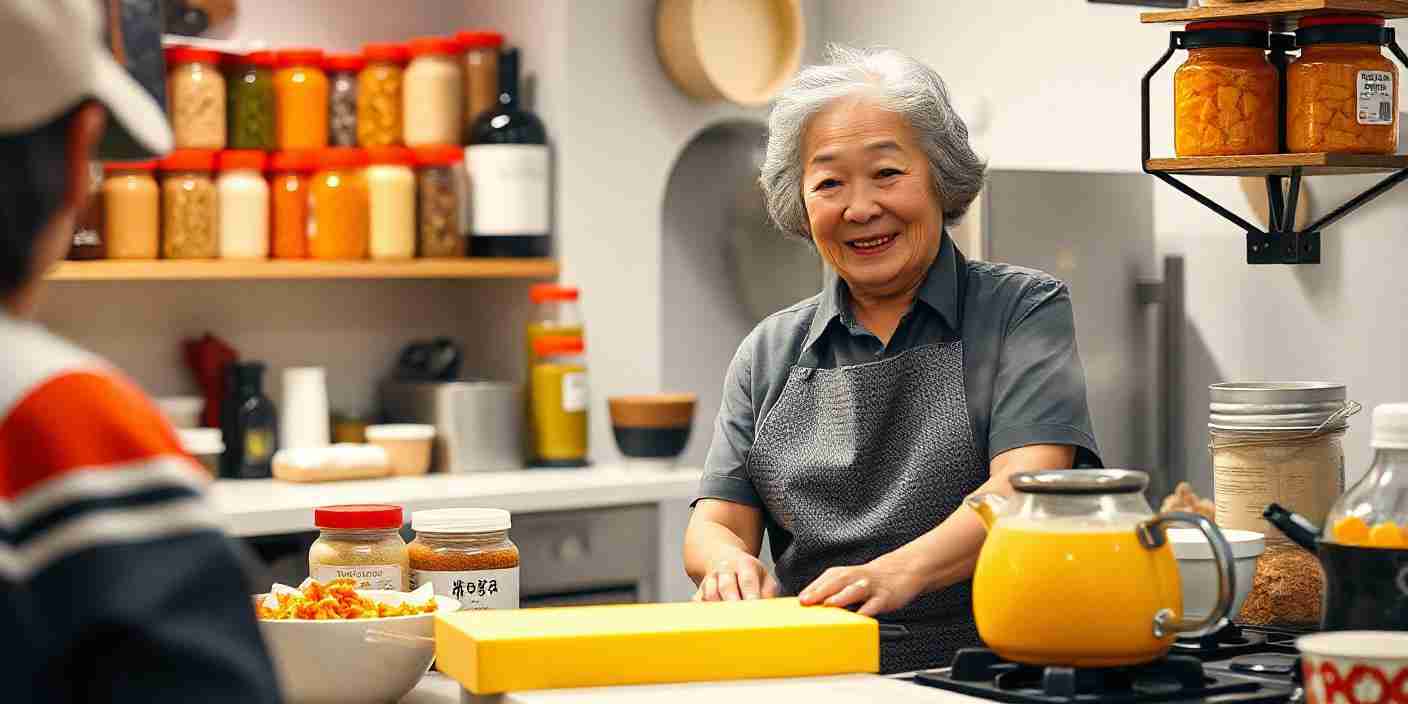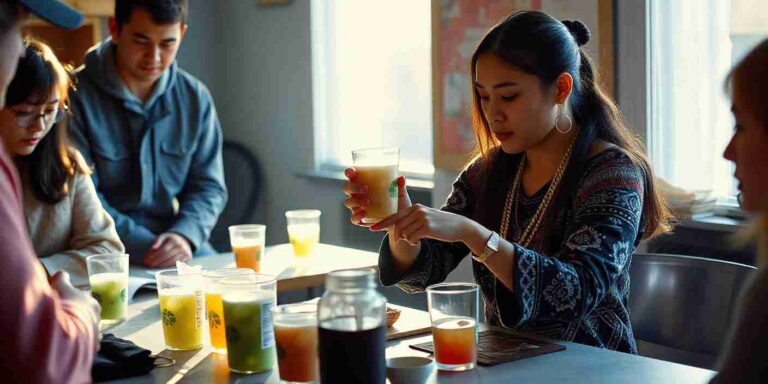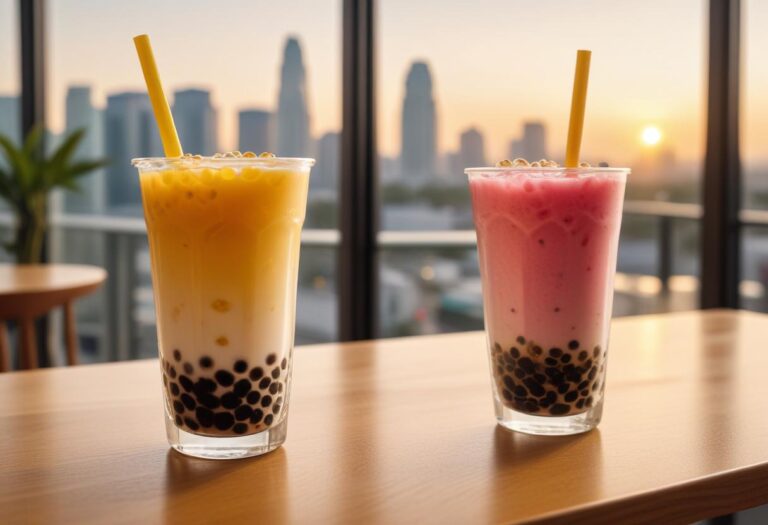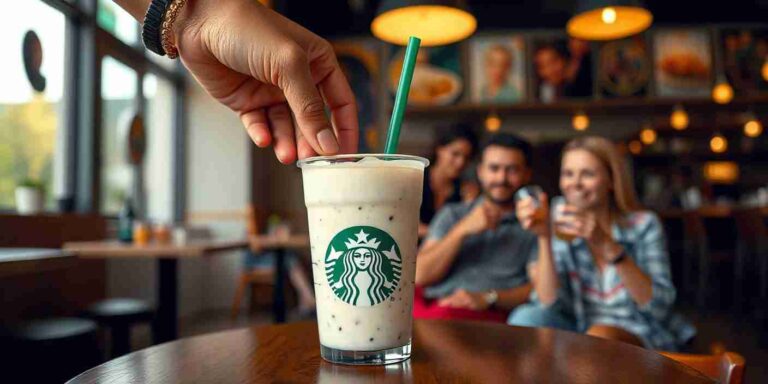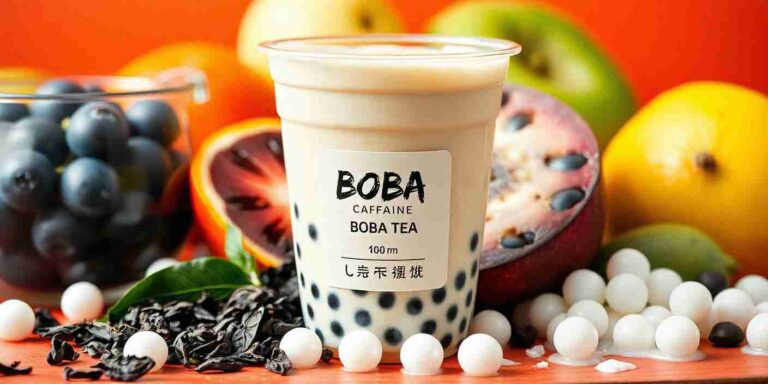Is Boba Tea Korean? Exploring Its Origins and Popularity in South Korea!
Boba tea isn’t Korean; it actually originated in Taiwan during the 1980s. This beloved drink, also known as bubble tea, has taken the world by storm with its chewy tapioca pearls and diverse flavors.
You might find yourself wondering how this Taiwanese treat became so popular across various cultures, including Korea.
In recent years, boba tea shops have popped up everywhere, even in South Korea. The fusion of Asian culinary influences has made boba a favorite among many.
Understanding its roots can enhance your appreciation for this delightful beverage and its journey from Taiwan to global stardom.
Key Takeaways
- Origins of Boba Tea: Boba tea, also known as bubble tea, originated in Taiwan during the 1980s and is not a Korean creation.
- Key Ingredients: The main components of boba tea include black or green tea, milk or creamer, sweeteners, and chewy tapioca pearls.
- Global Popularity: The drink has gained immense popularity worldwide, with the global bubble tea market valued at approximately $3 billion in 2022 and projected to grow.
- Cultural Significance: Boba tea serves as an important cultural symbol in Taiwan and has been embraced by various cultures globally, including South Korea.
- Korean Influence: In South Korea, boba tea has become popularized through K-pop culture while incorporating local flavors such as matcha and fruit purees.
- Modern Drink Trends in Korea: Trendy cafes now offer innovative drinks that blend traditional ingredients with contemporary tastes, showcasing the evolving beverage landscape in South Korea.
Is Boba Tea Korean?
Boba tea, also called bubble tea, is not Korean. It originated in Taiwan during the 1980s. The drink features chewy tapioca pearls and various flavors, which have made it popular worldwide.
While you may find boba tea in many countries, including South Korea, its roots are firmly in Taiwan. Taiwanese immigrants introduced boba tea to the United States in the 1990s, where it gained a large following.
Popularity of Boba Tea
In recent years, boba tea has become a favorite among people of all ages. According to market research, the global bubble tea market was valued at approximately $2 billion in 2021 and is expected to grow significantly by 2028. This surge reflects its widespread appeal across different cultures.
Key Ingredients
The main components of boba tea include:
- Tea: Usually black or green tea.
- Milk or Creamer: Adds creaminess.
- Sweetener: Sugar or other sweeteners for flavor.
- Tapioca Pearls: These chewy balls give texture and fun.
You can find many variations of this drink with unique flavors like matcha, mango, and taro.
Overall, while boba tea enjoys popularity in Korea and beyond, its true origin lies in Taiwan’s rich culinary history.
The Origins of Boba Tea
Boba tea, also known as bubble tea, has its roots in Taiwan. It started in the 1980s, when Liu Han-Chieh, owner of a tea shop called Chun Shui Tang, introduced cold tea to customers. Later on, tapioca balls, commonly referred to as “pearls” or “boba,” were added.
Historical Context
The history of boba tea traces back further than the 1980s. In the 1940s, Chang Fan Shu opened a tea shop selling unique hand-shaken teas that created rich iced teas with fine air bubbles on top.
This drink became known as foam tea and laid the groundwork for what would evolve into bubble tea.
With the rise of leisure food trends in Taiwan during the 1980s, boba gained popularity. In 1986, Tu Tsong He launched his own business venture inspired by this trend, further promoting boba’s development.
Regional Variations
While boba tea originated in Taiwan, it spread across various regions, each adding its twist. South Korea embraced this drink and made it their own by incorporating local flavors such as matcha and fruit purees.
Other regions also adapted recipes to cater to their tastes, resulting in diverse offerings like brown sugar milk and fruity blends.
Today, boba shops can be found worldwide. According to recent statistics from 2021, the global bubble tea market reached around $2 billion and is projected to grow significantly by 2028.
This growth reflects not just its Taiwanese heritage but also how it resonates with people across different cultures worldwide.
Cultural Significance
Boba tea holds significant cultural implications across different communities. Its roots in Taiwanese culture make it an important symbol of identity both in Taiwan and beyond.
Boba Tea in Korean Pop Culture
While boba tea originates from Taiwan, its popularity has spread to South Korea. Korean pop culture embraces boba through music videos, television shows, and social media. Many K-pop idols are seen enjoying boba tea, which boosts its appeal among fans.
In 2022, the global bubble tea market reached a value of approximately $3 billion, with South Korea contributing significantly to this growth as more stores open nationwide.
Boba Tea in Other Cultures
Boba tea transcends cultural boundaries and finds a home in various regions worldwide. In the United States, it’s become a key part of Asian American identity.
It represents a subculture where Taiwanese Americans and Chinese Americans connect over shared experiences.
Additionally, other cultures adapt boba by introducing unique flavors and ingredients to cater to local tastes.
For instance, fruit-flavored variants have gained traction in countries like Thailand and Japan, showcasing the drink’s versatility and widespread acceptance.
Comparisons with Korean Drinks
Boba tea, known as 버블티 (bubble tea) in Korea, has gained popularity alongside traditional Korean beverages. While boba tea isn’t originally from Korea, it fits well into the country’s modern drink trends.
Traditional Korean Beverages
Korean drinks offer a variety of flavors and experiences. Some popular traditional beverages include:
- Sujeonggwa: This is a sweet tea made with cinnamon and ginger. It’s often enjoyed after meals and provides warm comfort during colder months.
- Sikhye: A fermented rice drink that tastes sweet with a hint of sourness. It’s commonly served at celebrations and special occasions.
- Omija Tea: Made from the fruit of the omija tree, this tea features five distinct flavors—sweet, sour, salty, bitter, and umami—making it unique among beverages.
These drinks reflect Korea’s rich culinary history while offering distinct taste profiles compared to boba tea.
Modern Korean Drink Trends
In recent years, you’ll notice that Korean drink culture has expanded significantly. Trendy cafes now serve not only boba tea but also various innovative drinks combining traditional ingredients like matcha or fruits.
Some notable trends include:
- Fruit-infused teas: Many cafes mix fresh fruits into their beverages for added flavor and visual appeal.
- Cream toppings: Creamy layers on top of drinks enhance texture and richness.
- Health-focused options: With growing health awareness, many places offer lower-sugar or organic versions of popular drinks.
The blend of these modern elements showcases how traditional aspects can coexist with contemporary preferences in South Korea’s vibrant beverage scene.
Conclusion
Boba tea has undeniably made its mark in South Korea’s vibrant beverage scene. While it didn’t originate there it’s become a beloved choice among locals and tourists alike. The fusion of flavors and textures reflects the innovative spirit of Korean drink culture.
As you explore boba tea’s various interpretations in Korea you’ll discover how it complements traditional beverages while offering something new.
Whether you’re sipping on a classic bubble tea or trying a unique Korean twist, this drink continues to evolve alongside South Korea’s culinary landscape.
Frequently Asked Questions
What is boba tea and where did it originate?
Boba tea, also known as bubble tea, originated in Taiwan in the 1980s. It features a tea base mixed with milk or fruit flavors and chewy tapioca pearls.
How has boba tea expanded globally?
Boba tea has gained worldwide popularity, becoming a trendy beverage in many countries. Its adaptability allows for diverse flavor combinations and toppings, appealing to various tastes.
What is the cultural significance of boba tea in South Korea?
In South Korea, boba tea represents modern drink trends while integrating elements from traditional beverages. It showcases the country’s evolving culinary landscape.
How does boba tea compare to traditional Korean drinks?
Unlike traditional drinks like Sujeonggwa or Sikhye, which have distinct cultural roots, boba tea combines flavors and textures that cater to contemporary preferences.
What are some current drink trends in South Korea?
Current trends include fruit-infused teas, cream toppings on beverages, and health-focused options like herbal teas. This reflects a blend of tradition and innovation in Korean beverage culture.
